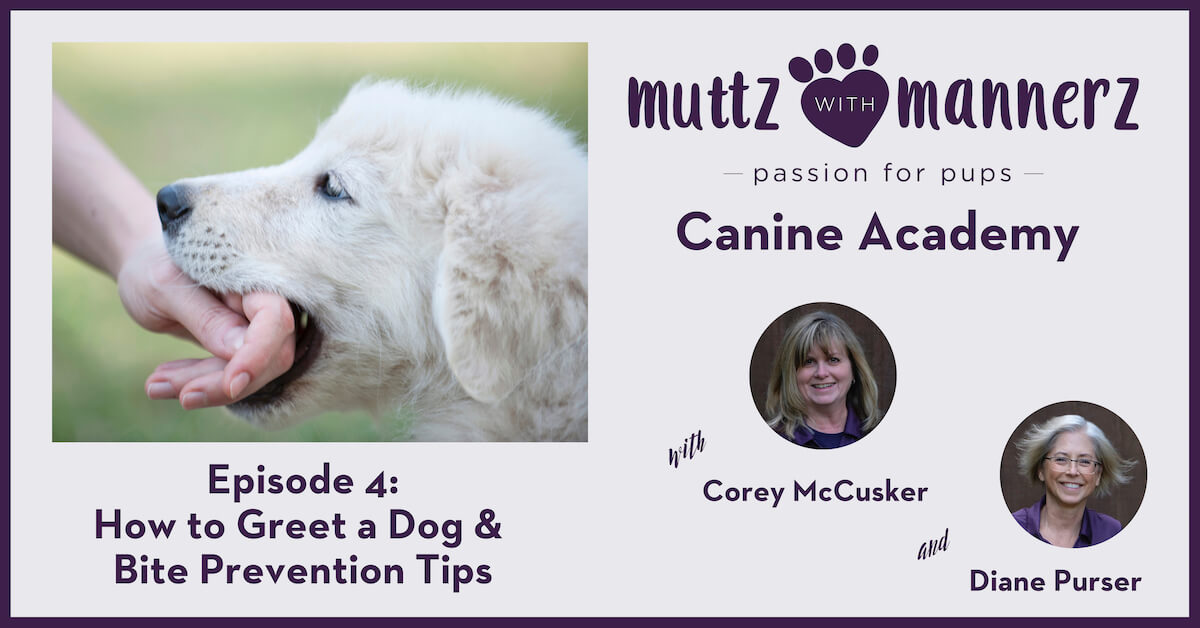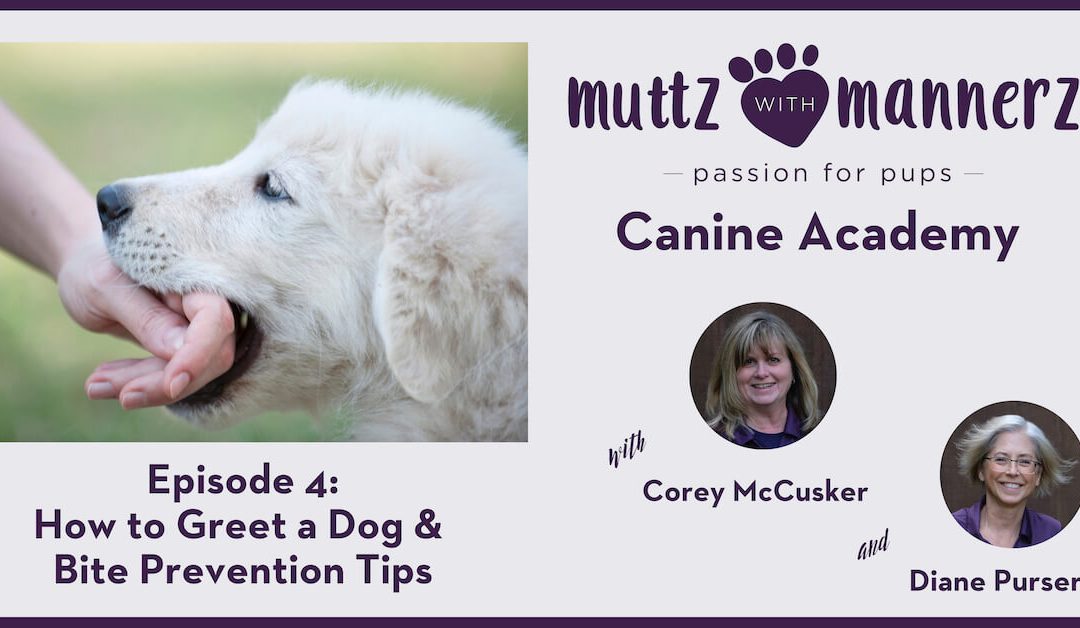
Corey McCusker 00:03
Hello dog lovers, and welcome to Muttz with Mannerz, Canine Academy Podcast, where we will share dog training tips and educational information to help you raise your pup – young or old – so they can be a loving part of your family and your community for life. I’m your host, Corey McCusker, Canine Coach, and along with me is Diane Purser, Canine Educator.
Diane Purser 00:27
Hi, everyone.
Corey McCusker 00:28
We have a passion for pups, and we thank you for joining us today. Today’s topic is dog bite prevention and how to meet a dog properly.
Diane Purser 00:39
Corey, this topic is so important, as are all the others. But this one is particularly near and dear to my heart. Because not only is your dog’s life at risk if it bites someone, but it’s also impacting the humans – especially if it’s a child on the end of the bite. Both of us have a lot of experience educating both dog owners and people who would like to know how to greet a dog properly and safely. So today, let’s talk about how to make sure your dog is comfortable during that experience.
Corey McCusker 01:15
I so agree. Today what we will cover off is what are we referring to what about dog bite prevention. We want to provide some tips on dog bite prevention for the owners and what is their responsibility. We’ll talk about some key steps on how to meet a new dog, which is especially important for kids, and how to prevent a dog bite if the dog is loose and comes and approaches you. And we will leave you with a summary of some key tips at the end.
Diane Purser 01:48
Usually the words, “Hi, can I meet your dog?” – is something that brings joy to a dog and their owner when they’re out exploring the neighborhood. But as you and I know, sometimes even the most playful and socially adjusted dogs can shy away from a meeting with a well-meaning visitor if that greeting isn’t handled properly.
Corey McCusker 02:11
Yes, Diane. You know what, just like humans, dogs have different personalities. Some are shy and timid. Some are really friendly and boisterous and playful. And then there are some that are very cautious and unsure. Dogs like certain things, and they dislike other things. Maybe they just like people petting a certain part of their body. I had a Maltese, Fred, who I loved dearly, and when I got him, when you went to pet him at the top of his head, he would shy away. And that’s what I call ‘head shy’. So we really have to think about how we’re approaching the dog and how we’re petting them.
Diane Purser 02:51
You know what, the greeting is absolutely everything. There’s no reason a pat from a new human friend can’t be positive for both the dog and their new friend. If everyone just follows a few simple steps,
Corey McCusker 03:05
For sure. A few simple steps, for both the owner and the greeter, because they’re both responsible for making sure that there’s a positive experience. So let’s talk about the dog owner’s responsibility. The owner’s responsibility is really to their dog. It’s really to protect them and not allow them to get into situations where they are potentially not comfortable. The last thing the owner wants is for their dog to be scared or concerned and develop a long-term fear of people. First and foremost, I have to say, always walk your dog on leash, always. Why? One, it’s a safety issue. If your dog gets fearful and bolts, and also some people don’t want to meet a dog, so it allows you to manage how the dog is walked. If you know that your dog is not comfortable being approached, or if they’re recovering, say from an injury or an illness or not feeling good and they’re just not in the mood that day to meet anyone, don’t be concerned or embarrassed about stepping in as someone approaches. Let them know in a pleasant, friendly, calm voice that your dog just isn’t in the mood – does not want to meet new people that day. You can also simply avoid the situation by moving in a different direction or giving yourself more space around the person approaching. If your dog does like to meet people, then you should let them know how your dog likes to be pet, after they follow a few simple steps. Once you sense that the dog has had enough, then continue with your walk so the meeting ends on a positive note. As we say, keep it short and sweet. Some dogs get so excited when they meet a new person that they want to just jump on them, and they just get so excited when they want to meet that person. So again, make sure they’re on leash, and only allow the person greeting your dog to greet your dog if they have all four paws in the ground,
Diane Purser 05:10
Corey, that’s perfect advice. So, let’s talk about the steps for greeting a dog. First and foremost, always ask the owner before you try to pet their dog. The owner knows best what the dog likes and doesn’t. So please respect the owners wishes. They know best and are only looking out for their dog’s welfare. Now, most of the time, the dog owners usually say, “Yes, of course you can.” And when they do, then please follow these, our recommended steps. One, approach calmly, with your hand extended low towards their nose and let the dogs sniff you. Avoid patting the top of their head first. Don’t tower over the dog. And that’s sometimes the position you’re in when you do go to pat their head, because this can often scare them, and they will step away from you. Even though they could smell you well before you put your hand out, letting them smell your hand is still a gentle gesture that allows you and the dog to connect first.
After the dog has smelled your hand, then gently take your hand and pat or rub them under the chin or the side of the face. The reason why we say under the chin is because the dog can see where your hand is and knows where it’s going. It’s much less threatening to them. The dog or the owner will let you know that they are comfortable, and chances are they will want you afterwards to pet their backs or bellies. And that will be very obvious, I’m sure. While everyone is still enjoying the meeting, as you said Corey, take your leave to end the visit on a positive note.
Our advice, even with your own dogs, is that every time you meet a dog, start by patting them under the chin. It’s a nice way to say hello and keep your dog’s trust. Just like your dog, Corey, I had one in particular, Tippy, and I have one now, Lola, who are also head shy. And the very best thing and the kindest thing I can do whenever I come up to them or anyone does, is to start by patting them under the chin first. It just makes them feel calmer and more secure. Now, we just talked about how to meet a dog properly, so that you and the dog are comfortable. But let’s talk about how to prevent a dog bite.
Although it’s important for everyone to understand what to do around a dog that’s off leash, and that’s where you’re most likely to see something like this happen. The dog is running free in some way because they’re without their owner. This information is important to everyone, but it’s particularly important for children. Because of their smaller size, their higher pitched voices and their lack of experience, they can be put into a potentially worse situation. So what do we do? What does everyone do?
First, if you see a stray dog, a dog that is on its own without its owner, do not approach it. Even if you know the dog. You don’t know how the dog is feeling or if it will react the same way as it would with its owner. Stay very still until the dog moves on, and don’t make eye contact. Be aware where it is, but don’t stare at it. Peer away at something else farther away. Do not yell or run away as this may also cause the dog to chase you. Once the dog has moved away, then contact the owner – if you know the dog – or animal control to come and take care of the dog and find its home. Now, if that dog decides that it doesn’t want to leave and it actually starts to jump on you or tries to bite you, then the very best thing to do is lie down on the ground, on your stomach, and stay very still. You don’t want the dog to be attracted to you. Do not move until the dog is gone or someone comes to help. Now if a dog tries to get you to leave an area – you’ve walked into someone’s yard, you’ve walked into a room, anywhere where the dog is there and now all of a sudden they are coming after you, they want you out – then very slowly start to back away. Avoid contact again or staring at the dog, and if possible, if you have something with you like a large purse, knapsack or a bike, skateboard, keep that between you and the dog just as a little bit of extra protection.
Corey McCusker 10:09
Great steps, Diane. So let’s talk about how to prepare your dog for greetings. Socializing your puppy to a new situation is very important. We’ve talked in other podcasts about puppy socialization and some key tips and we’ll provide a tip sheet for you in the show notes. When you get your new puppy or your dog, get them comfortable with family members first by practicing greetings. So getting family members to greet the dog properly. Diane just gave us some tips about underneath the chin. Remember also all four paws on the ground when they are greeted. So if your dog is jumpy, make sure they’re on leash, and let’s teach them how to sit nicely when somebody approaches them. Have everyone greet your new puppy every time just like it’s the first time.
Diane just shared a great story about her dog Tippy and with Lola, that she does it the same underneath the chin so it’s familiar to them. This really ensures that the dog has a good sense of what to expect. And remember, as I just said, always have your dog on leash when you are doing the greetings. I want to thank everyone for joining us today to learn about how to greet a dog properly and about bite prevention. To learn more or listen to other podcasts, please visit our website www.muttzwithmannerz.com. If you have any ideas for future podcasts, or any questions, please email Corey@muttzwithmannerz.com. Thanks so much for joining us. And, Diane, any last words?
Diane Purser 11:51
Yep, thanks everyone again, and I just want to say, think about your dog’s well-being and don’t be worried or embarrassed if your dog doesn’t want to greet every person that comes along.
Corey McCusker 12:04
Great tip. Thanks everyone. Have a great day.

